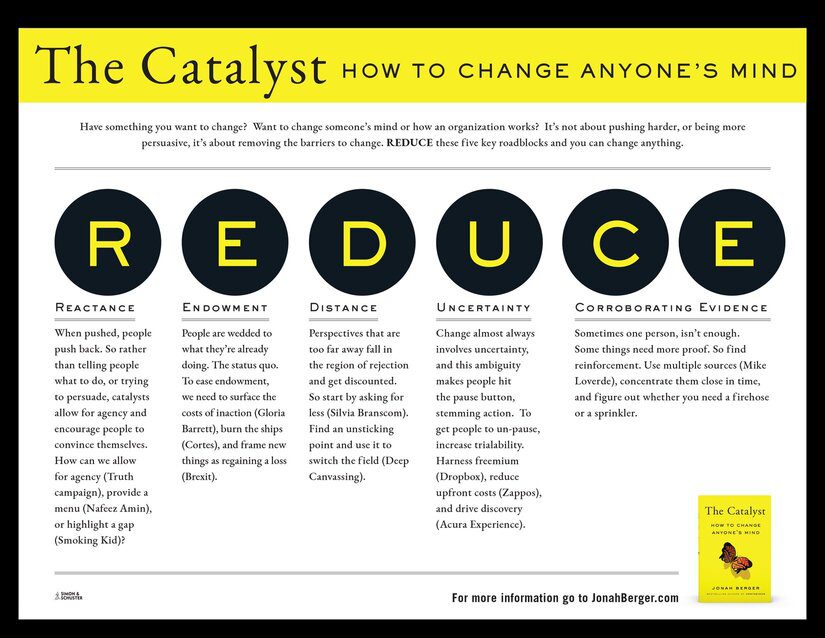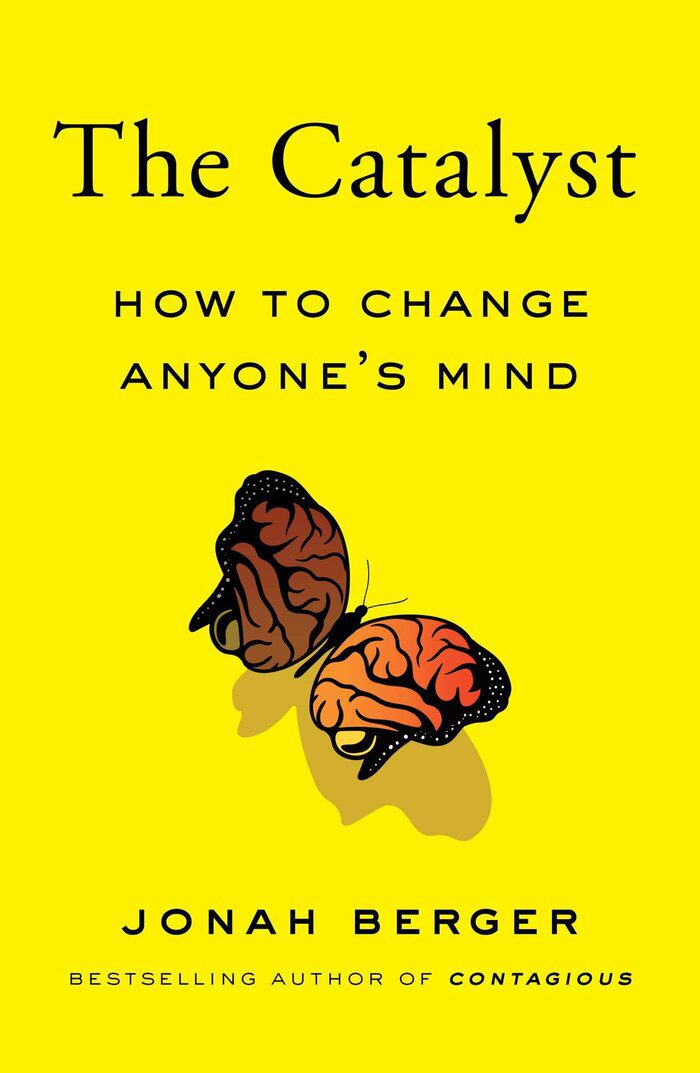This is probably one of the hardest lessons that I am beginning to finally learn the hard way. My default is always to try to add value to people’s lives. Still, I found of late that it could come across as “Adding too much value,” as executive coach Marshall Goldsmith noted in his though-provoking book: What Got You Here Won’t Get You There: How Successful People Become Even More Successful! Author John C. Maxwell often said, “No one cares how much you know until they know how much you care.” Reach for the heart before the heart. Most of the resistance we often get when trying to influence, instruct, teach, and add value to people, usually comes from not first connecting with them where they are.
“People change when they … Hurt enough that they have to, Learn enough that they want to, and Receive enough that they are able to.” – John C. Maxwell

In his book, The Catalyst: How to Change Anyone’s Mind, author Jonah Berger introduces the REDUCE (Reactance, Endowment, Distance, Uncertainty, and Corroborating Evidence) framework for effecting change and influencing people. He writes:
Reactance
Pushing, telling, or just encouraging people to do something often makes them less likely to do it.
When pushed, people push back. Just like a missile defense system protects against incoming projectiles, people have an innate anti-persuasion system. Radar that kicks in when they sense someone is trying to convince them. To lower this barrier, catalysts encourage people to persuade themselves. Restriction generates a psychological phenomenon called reactance. An unpleasant state that occurs when people feel their freedom is lost or threatened.
Solution to Reactance
Allow for Agency
- “To avoid reactance and the persuasion radar, then, catalysts allow for agency. They stop trying to persuade and instead get people to persuade themselves.” To reduce reactance, catalysts allow for agency—not by telling people what to do or by being completely hands-off, but by finding the middle ground. By guiding their path.

Four key ways to do that are:
(1) Provide a menu,
- Try to convince people to do something, and they spend a lot of time counterarguing. Thinking about all the various reasons why it’s a bad idea or why something else would be better. Why they don’t want to do what was suggested.”
But give people multiple options, and suddenly things shift.
(2) ask, don’t tell,
Questions encourage listeners to commit to the conclusion. To behave consistently with whatever answer they gave.
- Rather than taking a predetermined plan and pushing it on people, catalysts do the opposite. They start by asking questions. Visiting with stakeholders, getting their perspectives, and engaging them in the planning process.
(3) highlight a gap,
- People strive for internal consistency. They want their attitudes, beliefs, and behaviors to align. Someone who says they care about the environment tries to reduce their carbon footprint. Someone who preaches the virtues of honesty tries not to tell lies.
- Consequently, when attitudes and behaviors conflict, people get uncomfortable. And to reduce this discomfort, or what scientists call cognitive dissonance, people take steps to bring things back in line.
Highlighting such dissonance, and bringing it to the fore, encourages people not only to see the discord but also to work to resolve it.
(4) start with understanding.
- Before people will change, they have to be willing to listen. They have to trust the person they’re communicating with. And until that happens, no amount of persuasion is going to work.
- Seasoned negotiators don’t start with what they want; they start with whom they want to change. Working to gain insight into where that person is coming from. Comprehending and appreciating that person’s situation, feelings, and motives, and showing them that someone else understands.
Starting with understanding diffuses anti-persuasion radar by making sure the other side gets a chance to say their piece.
Meditations
Daily Calm with Tamara Levitt – Listening
Listening is a way of dealing with difficult people. We all have to deal with people who rub us the wrong way. It is an inevitable part of human interaction to be around people who are draining to be around and impossible to get along with. We can’t change the person in front of us, but we can work how we perceive them. Remembering that difficult people are often that way for a reason. When we get to know someone’s story, if we listen closely, we might find a woundedness behind their abrasive exterior, a suffering we could never have imagined.
With this understanding, it becomes easier to offer kindness. As we open up, we can develop more patience and gentleness than we ever thought possible. All we have to do is listen. The practice of deep listening not only shows the other person that we hear and understand them, but it also builds trust and a bridge so that they can also see us in a different light. If we put our judgments and pre-conceived notions aside for a moment and took the time to listen to the person in front of us truly.
‘Remember that everyone you meet is afraid of something, loves something and has lost something.’ – Jackson Brown
Daily Jay with Jay Shetty – Sound Design Your Life
Scientists have shown that exposure to loud noise can impair our learning and memory, while silence can have the opposite effect. Everything you hear adds to your cognitive load, so conflicting sounds give your brain too much input to process. We often don’t have total control over what we hear, but generally, we have more power than we realize to shape our sound space. Researchers found that bird songs, for instance, increase mood, decrease stress and enhance focus.
Daily Trip with Jeff Warren – A different kind of thinking
Podcast
- Weee!: Larry Liu | How I Built This with Guy Raz
All the best in your quest to get better. Don’t Settle: Live with Passion



Comments are closed.